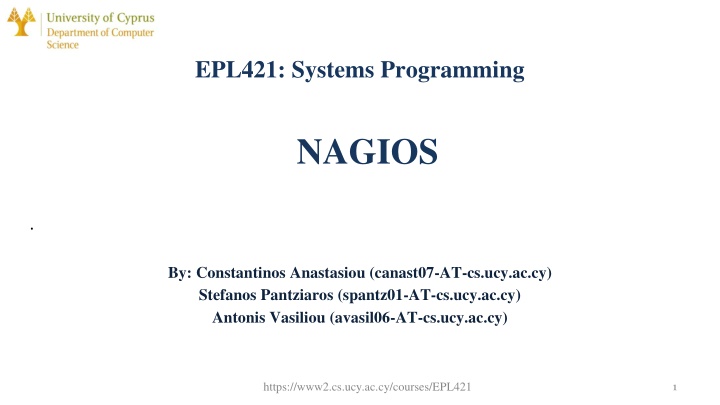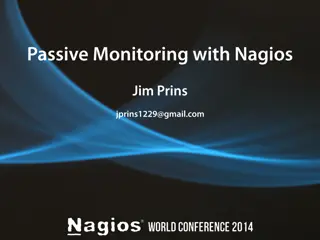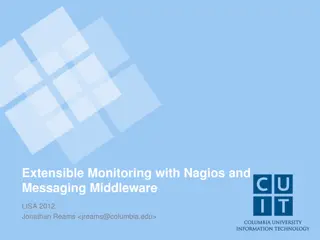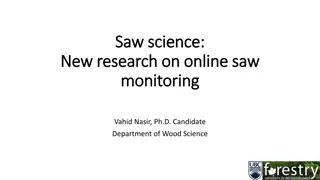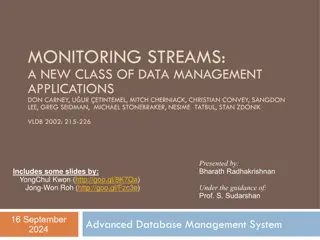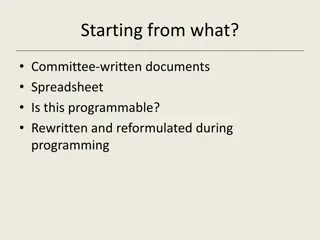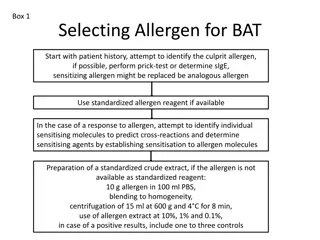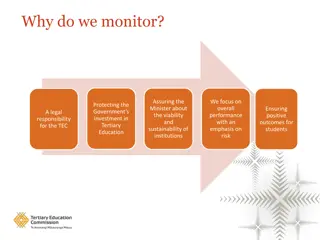Overview of Nagios Systems Monitoring Tool
Nagios is a powerful open-source monitoring system that can monitor systems, networks, and infrastructure. It offers customization through plugins and has a range of features for monitoring various aspects such as applications, databases, protocols, and more. Despite some limitations in the free version, Nagios is known for its flexibility and effectiveness in providing notifications and alerts for early issue prevention.
Download Presentation

Please find below an Image/Link to download the presentation.
The content on the website is provided AS IS for your information and personal use only. It may not be sold, licensed, or shared on other websites without obtaining consent from the author.If you encounter any issues during the download, it is possible that the publisher has removed the file from their server.
You are allowed to download the files provided on this website for personal or commercial use, subject to the condition that they are used lawfully. All files are the property of their respective owners.
The content on the website is provided AS IS for your information and personal use only. It may not be sold, licensed, or shared on other websites without obtaining consent from the author.
E N D
Presentation Transcript
EPL421: Systems Programming NAGIOS . By: Constantinos Anastasiou (canast07-AT-cs.ucy.ac.cy) Stefanos Pantziaros (spantz01-AT-cs.ucy.ac.cy) Antonis Vasiliou (avasil06-AT-cs.ucy.ac.cy) https://www2.cs.ucy.ac.cy/courses/EPL421 1
Nagios (1) Monitoring system Monitors systems, networks and infrastructure Nagios Core Open Source Software Nagios Plugins separate Nagios project. Nagios XI Extended Interface (Enterprise), maintained by Nagios Enterprises and Ethan Galstad(Standard Edition starts at $1,995) https://www.cs.ucy.ac.cy/courses/EPL421 2
Nagios (2) Alternative systems: Can monitor: 1996 Ethan Galstad creates MS-DOS application to ping Novell Netware servers and pages. 1998 build new improved application to run under Linux. 1999 release as open source under the name NetSaint 2002 Change to Nagios (Nagios Ain t Gonna Insist On Sainthood) 2008 Nagios Enterprises, LLC is founded by Ethan Galstad 2008 Nagios is downloaded directly from SourceForge.net over 500,000 times. 2009 Nagios is renamed Nagios Core 2010-2018 Many versions were released (Nagios XI in 2015) 2019 Nagios 4.4.5, Nagios Plugins 3.2.1, Nagios XI 5.6.8 PANDORAFMS Icinga LibreNms Zenoss Website Monitoring (Application, Transactions, Hijack Detection, Content Monitoring, etc) OS Monitoring (Windows, Linux, Servers, RHEL, Centos, AIX, etc.) Database Monitoring (MS SQL, Postgres, Oracle,DB2, MSSQL) Protocol Monitoring (HTTP, FTP, DNS, SNMTP, SMTP, LDAP, etc.) Managed Service Providers (Passive checks, scalability, Distributed Monitoring) Environmental Monitoring Power Monitoring (UPS) Storage Monitoring (File systems, files, directories, RAID Array & RAID Controller Monitoring, etc.) Email Monitoring (Delivery monitoring, Postfix, Sendmail, IMAP, POP, etc.) https://www.cs.ucy.ac.cy/courses/EPL421 3
Nagios (3) PROS Open source software Easy to add custom scripts Can monitor many different systems Notification and Alert settings for early preventing of situations CONS All features are not provided in the free version A lot of configuration files Hard to configure Can t manage networks, only monitor them https://www.cs.ucy.ac.cy/courses/EPL421 4
Nagios (4) Available connections: NRPE - Nagios Remote Plugin Executor using scripts that are hosted on the remote systems, TCP port 5666 NRDP - Nagios Remote Data Processor agent with a flexible data transport mechanism and processor. NSClient++ - NRPE for Windows Machines monitors Windows machines, TCP port 12489 NCPA - Nagios Cross Platform Agent scale-able API that allows flexibility and simplicity in monitoring hosts installs on Windows, Linux, and Mac OS X https://www.cs.ucy.ac.cy/courses/EPL421 5
Prequisites System requirements 1 GHz Processor 1 GB RAM 8 GB HD Recommended system specs 2+ GHz Processor 2 GB RAM 40 GB HD RAID 5 Drive Configuration $sudo apt-get install -y autoconf gcc libc6 make wget unzip apache2 php libapache2-mod-php7.2 libgd-dev https://www.cs.ucy.ac.cy/courses/EPL421 6
Installing (1) Easy installation guides are available at assets.nagios.com for many OS. Download Nagios Core tar, compile and install the contents, Download Nagios Plugins, to use commands and install them, Download any of the files needed for the connection with the hosts (ex. NRPE). After installation configuration files, that need to be edited in order to work. 1. 2. 3. 7
Installing (2) /usr/local/nagios/etc/objects/servers$ cat 10.16.30.36.cfg /usr/local/nagios/etc/objects$ cat hostgroups.cfg /usr/local/nagios/etc/objects$ cat contacts.cfg define contact { contact_name usegeneric-contact Inherit default values from generic-contact template alias email } define contactgroup { contactgroup_name alias members nagiosadmin2, nagiosadmin3 } define hostgroup { # Short name of user define host { # hostgroup_name Linux_servers use host_name alias address max_check_attempts check_period notification_interval notification_period contact_groups admins hostgroups linux-server #name of host #alias name 10.16.30.36 # Full name of user #user email address alias Linux Servers } 5 admins 24x7 Nagios Administrators nagiosadmin, /usr/local/nagios/etc/objects$ cat timeperiods.cfg 30 24x7 define timeperiod { name 24x7_sans_holidays linux-servers } define service { /usr/local/nagios/etc/objects$ cat commands.cfg define command { command_name command_line $HOSTADDRESS$ -w 3000.0,80% -c 5000.0,100% -p 5 } define command{ command_name command_line w $ARG1$ -c $ARG2$ } timeperiod_name 24x7_sans_holidays check-host-alive $USER1$/check_ping -H alias 24x7 host_name ubuntu service_description DDoS check_command check_ddos!50!70 max_check_attempts 5 check_period 24x7 notifications_enabled 1 check_interval 0.30 notification_interval 30 notification_period 24x7 contact_groups admins } Sans Holidays use us- holidays Get holiday exceptions from other timeperiod check_ddos $USER1$/check_ddos.pl - sunday 00:00- 24:00 Monday 00:00- 24:00 tuesday 00:00- 24:00 wednesday 00:00- 24:00 8 Thursday 00:00- 24:00
Installing (3) sudo /usr/local/nagios/bin/nagios -v /usr/local/nagios/etc/nagios.cfg #Run pre-flight check on configuration data sudo systemctl restart nagios.service sudo systemctl start nagios.service sudo systemctl stop nagios.service sudo systemctl status nagios.service 9
Hosts Hosts groups https://www.cs.ucy.ac.cy/courses/EPL421 13
Services https://www.cs.ucy.ac.cy/courses/EPL421 14
Warnings ***** Nagios ***** Notification Type: PROBLEM Service: Current Load Host: ubuntu Address: 10.16.30.36 State: WARNING Date/Time: Sun Nov 24 13:30:26 EET 2019 Additional Info: WARNING - load average: 0.97, 4.12, 2.29 https://www.cs.ucy.ac.cy/courses/EPL421 15
Recovery ***** Nagios ***** As soon as the default values are restored, Nagios will inform the contact group. Notification Type: RECOVERY Service: Current Load Host: ubuntu Address: 10.16.30.36 State: OK Date/Time: Sun Nov 24 13:33:16 EET 2019 Additional Info: OK load average: 0.001, 0.33, 2.97 https://www.cs.ucy.ac.cy/courses/EPL421 16
pnp4nagios Add-on to Nagios which analyzes performance data provided by plugins and stores them automatically into RRD-databases https://www.cs.ucy.ac.cy/courses/EPL421 17
DDoS Attack ab -c 1000 -k -n 1000000 http://10.16.30.39:80/ ab: Apache Benchmarking. A tool for benchmarking your Apache Hypertext Transfer Protocol (HTTP) server. -k: Keep Alive -c: Number of Concurrent requests -n: Total number of requests to be made DDOS_attack.mp4 DDOS_attack.mp4 18
Summary (1) Once installed, we only need to create/edit configuration files. To add a host we have to create a .cfg file with the name of the host to be monitored and define the services that will be monitored. For each service we have to use commands from the plugins we installed, or we can create our commands. After each modification we have to restart Nagios service to apply all modifications. https://www.cs.ucy.ac.cy/courses/EPL421 20
Summary (2) In case of an attack/error/failure Nagios monitors and informs the contacts defined in order to take measures. https://www.cs.ucy.ac.cy/courses/EPL421 21
Conclusions Nagios is a very useful tool for system administrators. It can show prevent major problems by monitoring servers and detecting problems. When a problem is found Nagios sends notifications to the administrators therefore, administrators can act as soon as possible. Nagios can make a system s administrators life easier by automating some routine functions that a system admin has to do. Also it provides a GUI that is easy to understand without needing specialized skills. Unfortunately many functions that Nagios provides aren t free. To get the full potential of it you would have to pay at least $1995. To set up Nagios you will have to be knowledgeable about systems programming. https://www.cs.ucy.ac.cy/courses/EPL421 22
Sources Nagios System and Network Monitoring, Wolfgang Barth, ISBN: 978-1-59327-070-4 https://assets.nagios.com/ https://www.dnsstuff.com/open-source-network-monitoring-tools https://sites.google.com/site/itcs465nagios/protocols-supported https://draculaservers.com/tutorials/install-nagios-ubuntu/ http://jo-roy.com/doku.php?id=nagios https://www.cs.ucy.ac.cy/courses/EPL421 23
THANK YOU! 24
